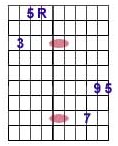







© 2011 Bob Culbertson
Chord Stacking Part 1
With the stick, the combinations of chords seem endless. In this lesson you will learn how to combine some simple triads to make many interesting and colorful chords.
First you need to know your Chord Chemistry lesson. You should also have a basic understanding of chord theory.
All "basic" chords are built on the idea of stacking 3rds. For example C major is C,E,G, C major 7=C,E,G,B C major 9=C,E,G,B,D and so on. If you look at a C major 7 you will notice you can play E minor chord on the melody side with a C note in the bass. If you want a C major 9 play G in the melody hand and C+E in the bass.
Here is the trick. I play the full C chord in the bass side and select the chord I want to extend it in the melody side. For example I might play C major in the bass and G in the melody Fig1. This makes a Cmaj9 chord.
With the stick, the combinations of chords seem endless. In this lesson you will learn how to combine some simple triads to make many interesting and colorful chords.
First you need to know your Chord Chemistry lesson. You should also have a basic understanding of chord theory.
All "basic" chords are built on the idea of stacking 3rds. For example C major is C,E,G, C major 7=C,E,G,B C major 9=C,E,G,B,D and so on. If you look at a C major 7 you will notice you can play E minor chord on the melody side with a C note in the bass. If you want a C major 9 play G in the melody hand and C+E in the bass.
Here is the trick. I play the full C chord in the bass side and select the chord I want to extend it in the melody side. For example I might play C major in the bass and G in the melody Fig1. This makes a Cmaj9 chord.

FIG 1
This technique can be used for minor chords as well. If you play Gmin in the bass and Dmin in the melody you will form a Gminor9 chord. Next you can play progressions using minor chords. Just flat the 3rd on both hands in the exercise above to get: Gmin9 / Cmin9 / Fmin9 / Bbmin9
Remember the 3rd in the melody chord is shown as the 7th on the diagram. This is because I am showing the whole chord in relationship to the root of the bass chord. In Chord Stacking 2 we will learn how to apply this to dominant chords.
Remember the 3rd in the melody chord is shown as the 7th on the diagram. This is because I am showing the whole chord in relationship to the root of the bass chord. In Chord Stacking 2 we will learn how to apply this to dominant chords.
FIG 2

*Notice I chose 2 shapes that match. A fun little improvisation I do is to play these chords all over the board in many unusual combinations.
Below is a 4 chord progression in 4ths. Fig2
Below is a 4 chord progression in 4ths. Fig2

Gmaj9 Cmaj9 Fmaj9 Bmaj9